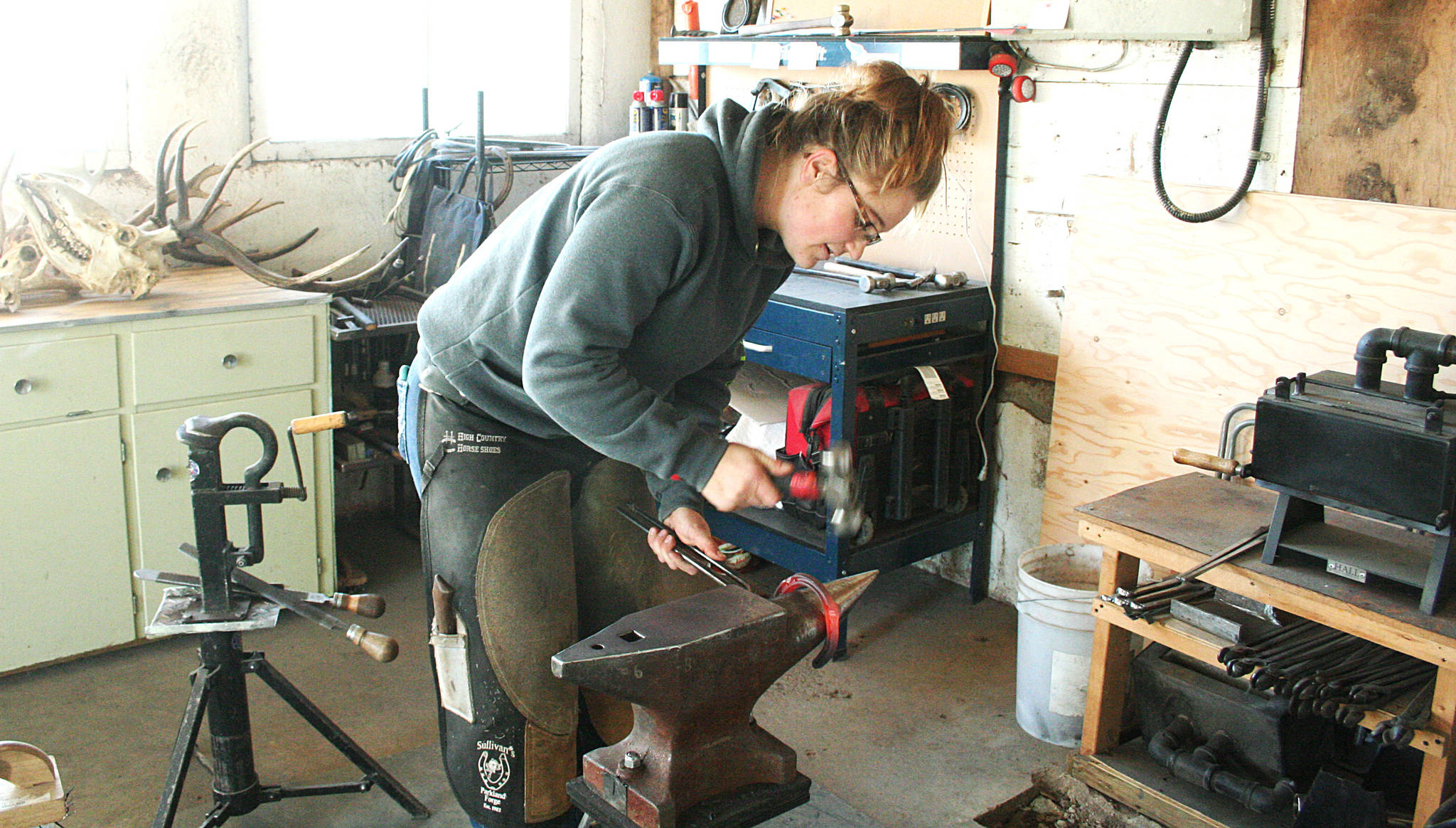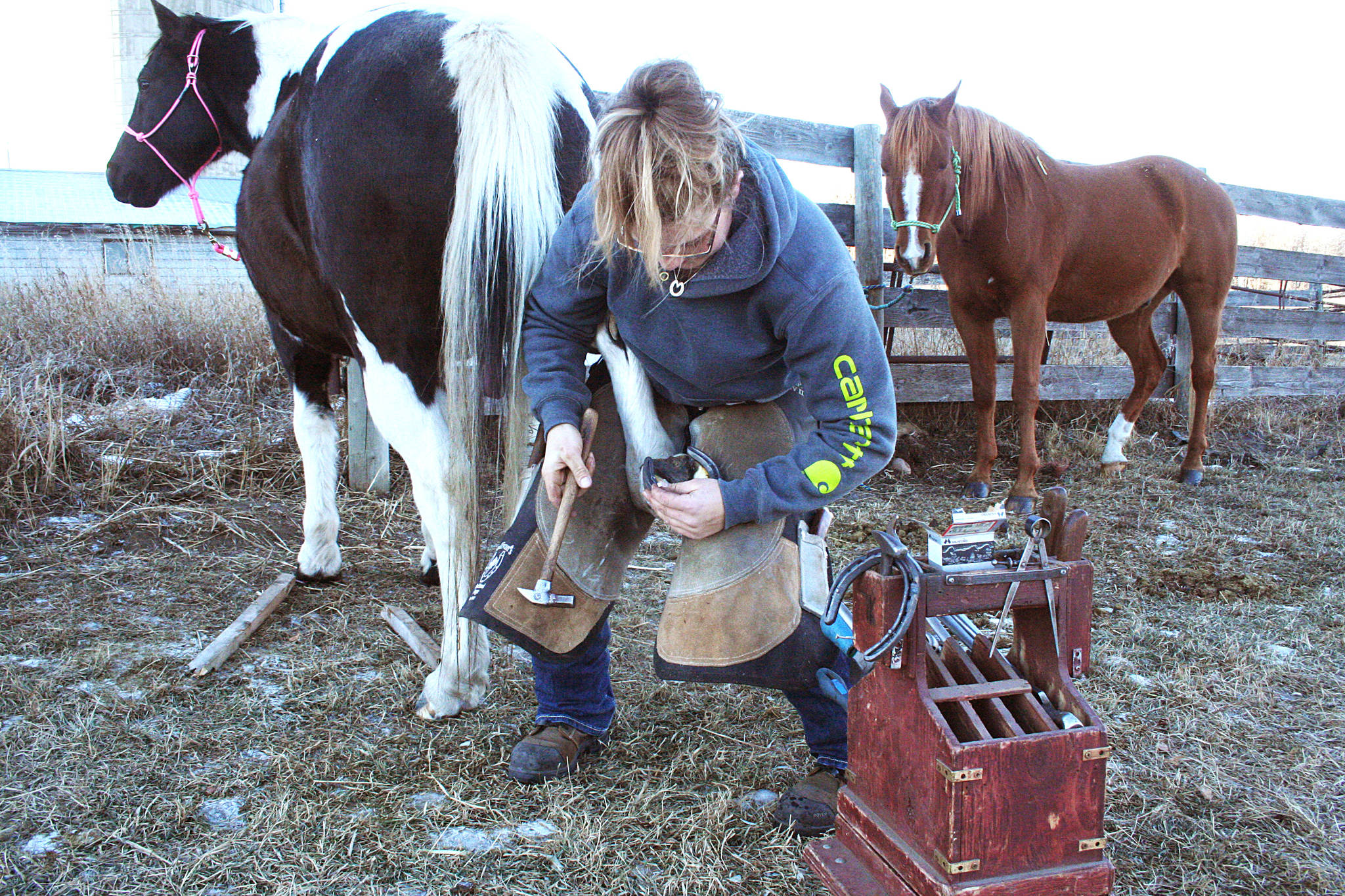Kim Lacey has been kicked and covered in blood but she has never given up on her goal of being a “proper” farrier, preparing horse’s hooves for shoes and making her shoes from scratch so they fit “proper.”
Despite the challenges of the trade, Lacey discovered she just wanted to keep going and developing her own style in the trade. This past summer she was funded by the American Farriers Association in travelling to the UK for more work experience.
Lacey loves it all, the business, the fact she works for herself and the artistry involved with creating shoes that fit a horse well.
“I just got passionate about it and didn’t want to quit,” she said. “I just really enjoyed it. I’ve always loved horses.”
She explained the farrier business isn’t just going out and slapping shoes on a horse. It’s a process that includes observing the horse as it walks toward her, assessing its anatomy and asking plenty of questions to understand what the rider is doing with the horse. She has to understand the job it’s about to do and know what the rider is doing with the horse.
Lacey is constantly asking herself questions about creating the best possible experience for the horse and the rider. She stays curious about improving the trim, applying a shoe that’s going to give the horse traction on ice or how she can help provide less traction to make a round go faster in a jumper ring. Having to problem solve like this is what gets Lacey going.
She also appreciates having the opportunity to work with a variety of horses - everything from the horses she has in her backyard to high end Arabian show horses all over the United States.
“It’s a hard job and there are days when you want to throw in the towel and quit,” she admitted. But she said it’s like anything else people love that keep them coming back despite the challenges.
“It’s something that just kinda clicked for me,” Lacey said. She feels fortunate to be able to to do what she does and feels lucky she figured out what she wanted to do early in life. She said she was also lucky to find an apprentice to work with.
“When you apprentice with someone, you don’t get paid very much but you get the knowledge,” she said. “You have to work your way up the ladder.”
To actually make a shoe from scratch is a process that is part understanding the horse’s anatomy, part measurement and part art. To master the trade takes years of practice and repetition.
“You just make shoes after shoes after shoes and after a while you figure out ‘if I have this much foot, I have to cut this much steel for it’,” she said while demonstrating how to prepare shoes she pre-made for one of her horses.
Depending on the size of the horse’s foot and the event they are participating in, there is a wide range of variables that affect the shoe-making process. Lacey’s pride in what she does is evident in her detailed descriptions of what she’s doing as she prepares a horse for shoeing.
Lacey says she’s always learning something new with every horse and every event she attends. It has taken her over three years to feel comfortable with the process of assessing a horse, creating a shoe that meets the horse’s needs and attaching the shoe to the horse. As she demonstrated heating up a shoe and preparing it for a fitting on her horse, she explained how a clip, the V-shaped portion at the top of a shoe, provides the strength for the shoe to stay on the foot with a few well-placed nails.
A farrier can choose between cold shoeing and hot shoeing. Lacey prefers hot shoeing as it sits more flush on the foot and creates a better seal that protects the foot from bacteria or microbes that could get in and cause damage. She also said it’s a a lot harder on your body to bang on a piece of cold steel as opposed to heated.
Lacey demonstrated putting “boxing” on the shoe, meaning she smoothes out the edges of the shoe so if the horse sets its hoof on the edge, the shoe simply slides off rather than being yanked off. While now there are grinders and power tools available, Lacey says you start learning by doing everything by hand. To demonstrate shoeing her horse, she does everything by hand from making the shoe to fitting it to her horse.
Lacey has ruined “too many shoes to count” over the years.
“There’s no natural way of doing things. It’s just a lot of practice,” she said, plunging the horse shoe in water to clean off the steel filings before placing it in her forge to heat it up.
Once a farrier becomes good at what they do, the process becomes comparable to sculpting in that you start to see all the minute adjustments needed to create a shoe to fit seamlessly with the hoof. From her 4H days until now, Lacey has developed an awareness of horses that serves her well in her job.
“You have to train your mind’s eye. It’s not just a physical demanding job,” Lacey said, explaining she’s drawn many pictures of hooves over the years to train herself to see more quickly what adjustments need to be made.
For the demonstration, Lacey used carbide tungsten ice pins which provide grip on the ice. She showed the grooves in the shoe that will fill up with dirt or snow to add a little bit of extra traction.
Lacey went out to try the shoe on her horse several times before nailing it on. A lot of damage can be caused without a proper fit.
“I find it takes more time to do it wrong,” Lacey said, referring to the time and care she takes in fitting the shoe to the horse.
Before demonstrating nailing on the shoe, Lacey double checked the shoe was flat. The amount of space a farrier has to nail into on the hoof of a horse is about the width of a dime, therefore nail placement is important. If the nails aren’t placed carefully they can go into sensitive tissue which can make the horse lame.
“You map out your foot so that your nail lines up with your heel and the widest part of your nail should line up with the widest part of your heel nails,” she explained. Lacey pounded in the nails confidently, sure of her measurements. She finished the job by clinching; taking the nail and bending it over the shoe, leaving no sharp edges.
Lacey’s favourite travel experience so far was Scotland. “Scotland was proper amazing,” she said, comparing her experience to being treated like royalty.
“Around the world I’ve had people just bring me into their homes,” she said, adding that many of the homes she’s stayed in were other farrier’s homes who’ve welcomed her into their world, their local pubs and shared tips of the trade.
While in the UK she had plenty of opportunity to work with other farriers at a variety of shows and contests, adding to her skill set. The Royal Highland Show was an experience that stands out most in her mind of the trip to Scotland.
“I’ve never worked so hard and drank so much in my life,” she said. Throughout the trip, she had the opportunity of working with a variety of masters in the trade including a family on the Scottish farrier team.
“If I find someone who’s a master in the craft I’m like, ‘how do you do that’,” she said.
Lacey was overewhelmed by all the support she recieved and all the expertise shared with her throughout the trip. “Every show and contest I went to everyone was willing to help,” she said. “It was just a good old friggin’ time.”
Lacey hopes the fact she’s pursued her passion so singlemindedly will show younger kids they don’t have to close themselves into their comfort zone.
“Go find something that you like to do. You open up and you blossom,” she said.
myra.nicks@sylvanlakenews.com
Like us on Facebook and follow us on Twitter

